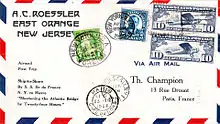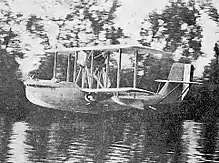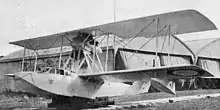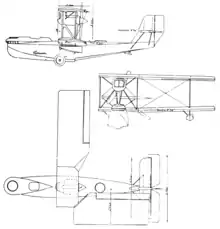CAMS 37
The CAMS 37 was a flying boat built in France in the mid-1920s that was originally designed for military reconnaissance, but which found use in a wide variety of roles in a large number of versions. It was the first design for Chantiers Aéro-Maritimes de la Seine (CAMS) by the company's new head designer, Maurice Hurel. The prototype was displayed at the 1926 Salon de l'Aéronautique in Paris. The prototype first flew in 1926, and after testing was ordered into service before the end of the year.[1] It was a conventional biplane flying boat very similar to previous CAMS designs, being driven by a pusher propeller whose engine was mounted on struts in the interplane gap. The first production version was the amphibious CAMS 37A that was bought by the French Navy, the Portuguese Navy and the aeroclub of Martinique.

| CAMS 37 | |
|---|---|
 | |
| CAMS 37A | |
| Role | Reconnaissance flying boat |
| Manufacturer | CAMS |
| Designer | Maurice Hurel |
| First flight | 1926 |
| Primary user | French Navy |
| Number built | 332 |
The aircraft became something of a jack-of-all-trades for the French Navy, operating from every Naval Air Station and from many capital ships. Some of the type's most significant moments were trials conducted by Compagnie Générale Transatlantique on the SS Île de France to evaluate the feasibility of catapult-launched mailplanes for their transatlantic liners using two specially-built 37/10s. Another famous use of the aircraft was on René Guilbaud's long-range flight through Africa and the Mediterranean between 12 October 1927 and 9 March 1927, venturing as far as Madagascar before returning to Marseille. In the course of the flight, he covered 22,600 km (14,000 mi) in 38 stages without incident.
The CAMS 37 was gradually phased out of operational service in the mid-to-late 1930s, and by the time World War II started in September 1939, the aircraft had been relegated to training and communication roles. On mobilisation, however, CAMS 37/11 trainers were used by two units for coastal patrol, with one unit, Escadrille 2S2 continuing in service until August 1940.[1] Outside mainland France, CAMS 37/11 trainers continued in use with a Free French unit in Tahiti until 15 January 1941, and with a Vichy France unit in Indochina until 1942 [1]
Variants

- 37
- Flying boat prototype, (one built).[2]
- 37/2
- pure flying boat version incorporating refinements from 37A amphibian (45 built).[5]
- 37 A/3
- reinforced hull (two built).[6]
- 37 A/6
- enclosed cabin admiral's barge for Aéronavale (three built).[7]
- 37A/7
- (or 37Lia) liaison amphibian (36 built).
- 37A/9
- metal-hulled officer transport for French Navy (4 built).[8]
- 37/10
- version for catapult trials (two built).[9]
- 37/11
- Four-seat liaison / trainer wooden-hulled version (110 built).[10]
- 37/12
- civil version with enclosed four-seat cabin (one built).[11]
- 37/13
- (or 37bis) metal-hulled version for catapult launching from ships.[12]
- 37GR
 CAMS 37GR photo from L'Aérophile December,1926
CAMS 37GR photo from L'Aérophile December,1926 - (GR – Grand Raids) A single long-range aircraft converted for the 37C prototype, flown by Lieutenant de Vaisseau Guilbaud, from l'Etang de Berre, in the company of Lioré-Olivier LeO H-194 on 12 October 1926, for a proving flight to Madagascar. On 3 January 1927 the engine threw a connecting rod, causing Guilbaud to abandon the Madagascar flight and return to Marseille on 9 March 1927, via Sudan, Egypt, Lebanon, Turkey, Greece, Malta and Tunisia.[13]
- 37LIA
- (aka 37 A/7) :see above
- 37C
- A single commercial transport prototype, converted to the sole 37GR
- 37E
- (E – ecole) Aéronavale designation for CAMS 37/11
- 37bis
- (aka 37/13) :see above
Specifications (37/2)

Data from Jane's all the World's Aircraft 1928,[3] Aviafrance, CAMS 37A[4]
General characteristics
- Crew: 3
- Length: 11.432 m (37 ft 6 in)
- Wingspan: 14.5 m (47 ft 7 in)
- Height: 4.04 m (13 ft 3 in)
- Wing area: 58 m2 (620 sq ft)
- Empty weight: 1,950 kg (4,299 lb)
- Gross weight: 2,850 kg (6,283 lb)
- Powerplant: 1 × Lorraine 12Ed Courlis W-12 water-cooled piston engine, 340 kW (450 hp)
- Propellers: 2-bladed fixed pitch propeller
Performance
- Maximum speed: 175 km/h (109 mph, 94 kn)
- Minimum speed: 90 km/h (56 mph; 49 kn) (Note: this is NOT minimum control speed which is only for aircraft with multiple engines)
- Range: 1,200 km (750 mi, 650 nmi)
- Service ceiling: 4,500 m (14,800 ft)
- Time to altitude: 3,000 m (9,800 ft) in 35 minutes
- Wing loading: 49 kg/m2 (10 lb/sq ft)
- Power/mass: 0.1182 kW/kg (0.0719 hp/lb)
Armament
- 2 × trainable 7.7 mm (0.303 in) Lewis guns in bow position
- 2 × trainable 7.7 mm (0.303 in) Lewis guns in dorsal position
- 300 kg (660 lb) of bombs carried under lower wing
References
- Green, William (1968). Warplanes of the Second World War, Volume Five, Flying Boats. London: Macdonald. pp. 15–17. ISBN 978-0-356-01449-4.
- Parmentier, Bruno. "C.A.M.S. 37". Aviafrance (in French). Paris. Retrieved 24 February 2018.
- Grey, C.G., ed. (1928). Jane's all the World's Aircraft 1928. London: Sampson Low, Marston & company, ltd. pp. 92c–93c.
- Parmentier, Bruno. "C.A.M.S. 37A". Aviafrance (in French). Paris. Retrieved 24 February 2018.
- Parmentier, Bruno. "C.A.M.S. 37/2". Aviafrance (in French). Paris. Retrieved 24 February 2018.
- Parmentier, Bruno. "C.A.M.S. 37 A/3". Aviafrance (in French). Paris. Retrieved 24 February 2018.
- Parmentier, Bruno. "C.A.M.S. 37 A/6 LIA". Aviafrance (in French). Paris. Retrieved 24 February 2018.
- Parmentier, Bruno. "C.A.M.S. 37 A-9". Aviafrance (in French). Paris. Retrieved 24 February 2018.
- Parmentier, Bruno. "C.A.M.S. 37/10". Aviafrance (in French). Paris. Retrieved 24 February 2018.
- Parmentier, Bruno. "C.A.M.S. 37/11". Aviafrance (in French). Paris. Retrieved 24 February 2018.
- Parmentier, Bruno. "C.A.M.S. 37/12". Aviafrance (in French). Paris. Retrieved 24 February 2018.
- Parmentier, Bruno. "C.A.M.S. 37/13". Aviafrance (in French). Paris. Retrieved 24 February 2018.
- Parmentier, Bruno. "C.A.M.S. 37 GR". Aviafrance (in French). Paris. Retrieved 24 February 2018.
Bibliography
- Bousquet, Gérard (2013). French Flying Boats of WW II. Sandomierz, Poland: Stratus. ISBN 978-83-63678-06-7.
- Cortet, Pierre (March 1999). "Des C.A.M.S. à coque "metal"" [C.A.M.S. Introduces a Metal Hull]. Avions: Toute l'aéronautique et son histoire (in French) (72): 37–39. ISSN 1243-8650.
- Cortet, Pierre (December 1999). "Courrier des Lecteurs" [Readers' Letters]. Avions: Toute l'aéronautique et son histoire (in French) (81): 4. ISSN 1243-8650.
- Morareau, Lucien (June 1998). "Courrier des Lecteurs" [Readers' Letters]. Avions: Toute l'aéronautique et son histoire (in French) (63): 2–3. ISSN 1243-8650.
- Morareau, Lucien (April 1999). "Courrier des Lecteurs" [Readers' Letters]. Avions: Toute l'aéronautique et son histoire (in French) (73): 2–3. ISSN 1243-8650.
- Morareau, Lucien (December 1998). "L'escadrille du bout du monde" [Squadron at the End of the World]. Avions: Toute l'aéronautique et son histoire (in French) (69): 42–51. ISSN 1243-8650.
- Morareau, Lucien (January 1999). "Des CAMS sur le Pacifique: L'escadrille du bout du monde (fin)" [The CAMS over the Pacific: Squadron at the End of the World]. Avions: Toute l'aéronautique et son histoire (in French) (70): 45–53. ISSN 1243-8650.
Further reading
- Taylor, Michael J. H. (1989). Jane's Encyclopedia of Aviation. London: Studio Editions. p. 226.
- World Aircraft Information Files. London: Bright Star Publishing. pp. File 891 Sheet 02.